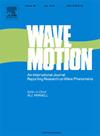一种新的波动方程层次控制方法
IF 2.5
3区 物理与天体物理
Q2 ACOUSTICS
引用次数: 0
摘要
本文给出了具有层次作用的波动方程的控制结果;领导者控制行动,追随者对这一行动做出反应,试图获得不同于领导者的目标。本文将经典Stackelberg策略中领导者具有可控性目标,追随者具有最优性目标的角色进行了反转。参见Lions (1994), Araruna et al. (2018), Araruna et al.(2020)。我们将考虑一个领导者的目标是最小化功能和追随者控制与一个精确的可控性目标。本文章由计算机程序翻译,如有差异,请以英文原文为准。
A new hierarchical control for the wave equation
This work present results on controlling a wave equation with a hierarchy of actions; a leader control acts and the follower reacts to this action trying to get a different target of the one of the leader. In this paper, we invert the roles of the classical Stackelberg strategies where the leader has a controllability target and the follower and optimization objective. See e.g. Lions (1994), Araruna et al. (2018), Araruna et al. (2020). We will consider a leader aiming to minimize a functional and a follower control with an exact controllability target.
求助全文
通过发布文献求助,成功后即可免费获取论文全文。
去求助
来源期刊

Wave Motion
物理-力学
CiteScore
4.10
自引率
8.30%
发文量
118
审稿时长
3 months
期刊介绍:
Wave Motion is devoted to the cross fertilization of ideas, and to stimulating interaction between workers in various research areas in which wave propagation phenomena play a dominant role. The description and analysis of wave propagation phenomena provides a unifying thread connecting diverse areas of engineering and the physical sciences such as acoustics, optics, geophysics, seismology, electromagnetic theory, solid and fluid mechanics.
The journal publishes papers on analytical, numerical and experimental methods. Papers that address fundamentally new topics in wave phenomena or develop wave propagation methods for solving direct and inverse problems are of interest to the journal.
 求助内容:
求助内容: 应助结果提醒方式:
应助结果提醒方式:


